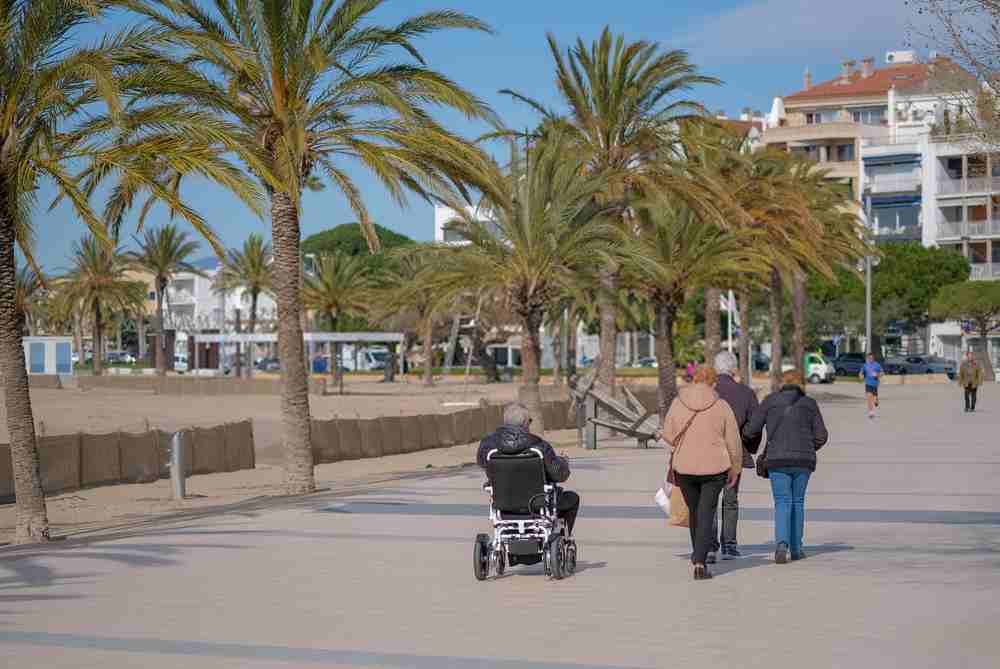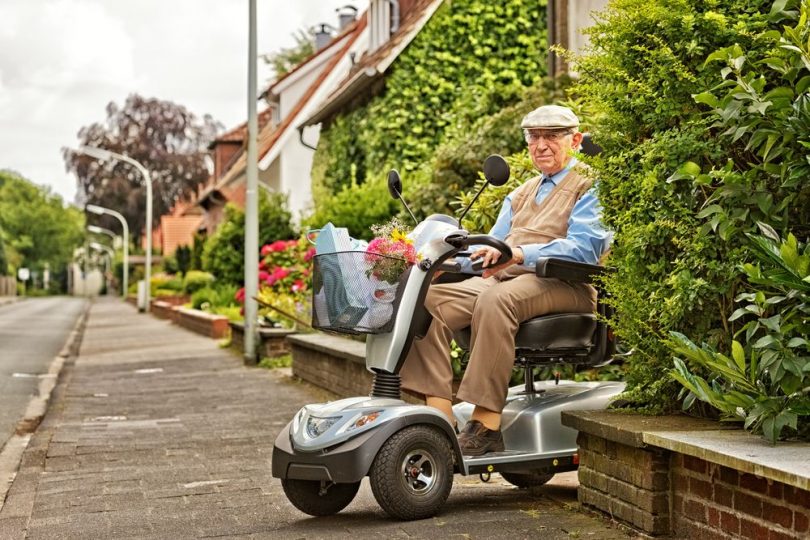Nowadays, mobility scooters are seen more than often in neighborhoods. People, generally older ones, are more interested in using them. They are used as a mobility aid, replacing wheelchair, in indoor and outdoor activities.
Now you do not need to take your car out every time you choose a quick grocery shopping or an afternoon trip around the block. You can hop on your mobility scooter for a ride. So you might worry how far a mobility scooter can go on a full charge.
There are different types of scooters available that vary in size, weight capacities, battery management, and other functionality. Thus the distance a scooter can go on a single charge differs for many reasons.
3 Types of Mobility Scooters & Their Average Speed Limits
1. Portable boot scooters
Portable boot scooters are compact and lightweight. These scooter types are easy to disperse and reassemble. You can disunite them into 3 to 4 parts and put them inside your car’s boot. For this reason, they come in small sizes and limited distance range.
With a single charge, you should be able to cover 10 miles of distance per hour, with an average speed of 4mph-5mph. Needless to say, they are very slow. Likely you cannot travel a long distance on them.
These small boot scooters are great for your visit to the supermarket or grocery shopping. A portable 3 wheeled boot scooter is a fitting replacement of wheelchairs for your indoor movements.
2. Mid-range scooters
Mid-range scooters are a good option for both indoor and outdoor use. If you have the plan to hop on your mobility scooter almost every day, then a mid-range scooter should be your go-to choice. They are similar to portable boot scooters with the same speed limit of around 4mph-5mph as well as foldable options. The difference comes in the weight capacity and the larger batteries.
As it has bigger seats, tall folks can comfortably ride on it. Moreover, these scooters can carry extra weight compared to portable ones.
A mid-range mobility scooter can cover 15 to 20 miles with a full charge, thanks to the bigger batteries. So you can utilize it for your regular uses. You can find them in both 3 wheeled scooters and 4 wheeled scooters, whichever you prefer.
3. Road-legal scooters
Road-legal scooters, also known as the Class 03 scooters, are the most powerful types among the three. They are more spacious with handles, headlights, breaks, rearview mirrors, working horns, and bigger wheels. The overall large frame gives more space for batteries and resilience.
These road-legal mobility scooters have a speed range starting from 4mph to a maximum of 8mph. So along with the big batteries installed in it, you can travel up to 35 to 40 miles within a single battery life.
Though it is discouraged to ride road-legal scooters on roads, you can drive them on the bike lane. Do not forget the helmet when you take them on the roads.
Battery Size & Capacity
Although all batteries in a scooter are replaceable, battery size needs to be considered according to your scooter’s model. An electric boot scooter will need two pairs of 12v batteries. So you will need a total of 24v Amp to operate your mobility vehicle.
Whereas 6-8mph class 3 scooters can have up to 70Ah battery capacity, depending on the model. So when you choose a battery for your mobility scooter, you should consider the battery size and battery capacity accordingly.
Battery Type
1. Lead-acid Batteries
Lead-acid batteries or VLRA (Valve-regulated Lead Acid) are for those who use their vehicle occasionally. You can either go for a GEL battery or AGM (Absorbed Glass Mat) battery. Both of them are known as sealed lead batteries.
GEL cell batteries and AGM batteries are both
- Sealed
- Maintenance-free
- Easily replaceable
- Safe to charge inside the house
- Shock-resistant
GEL batteries are more durable than the latter. Though more expensive, we recommend regular mobility scooter users to use GEL batteries because of their longevity. They provide a steady flow of power to the motor. It might take several charges for these batteries to raise up to their ample capacity.
Most of the 6-8mph scooters run on GEL cell batteries, providing 70Ah battery capacity, for fastest ride.
2. Lithium-Ion batteries
Li-ion batteries are principally for portable boot scooters. They are somewhat new in the market. Conversely, it is rising in popularity, especially for its lightweight variety. They also have arguably 3 times longer lifespan than SLA batteries.
Like GEL or SLA batteries, Li-ion batteries are also easy maintenance and replaceable. Though they are the most expensive batteries, their longevity and performance cover up for their cost.
- Lighter than GEL batteries
- Longer lifespan
- Produce less waste
- Easy maintenance
- Comes with a protective case
- No fire hazard risk
Mileage Covered on a Single Charge
How far you can go on a single charge will depend on the mobility scooter and other factors like battery age, health, and weight management. It should be able to go 10 to 40 miles depending on the mobility scooter models.
For better understanding, you should always follow the guidelines provided by the manufacturer. You have to charge the batteries for at least 8 hours. Do not worry about overcharging the batteries. With advanced technology, you can keep them plugged in for overnight charge. We believe that it is better to fully charge the batteries before or after you use the scooter.
Longest Travel Distance
A mid-range mobility scooter can cover up to 10 to 15 miles. Keeping this in mind, you should not take them out for an extended period.
Whereas road-legal scooters can go anywhere from 30 miles on a single charge. The longest travel distance on a mobility scooter is about 40 to 45 miles. By all means, the battery type, weight carried on the scooter, or any bumps or hills on the road will alter the travel distance.
How Far Can a Mobility Scooter Go – Factors that Determine the Distance

1. Battery age
Battery age can slow down your scooter’s distance coverage. With proper maintenance, a battery can last up to 18 to 24 months. It all depends on the heavy-duty usages.
To extend battery life, always fully charge the batteries. Do not use them on low charge or till it goes flat.
2. Tire pressure
Almost all types of mobility scooters wheels have air pressure around 35 PSI to 45 PSI. An underinflated tire will not give the expected mileage even with fully charged batteries. It can also cause an accident on bumpy roads. So always check your tire pressure.
3. Rider Weight
If the rider’s weight is more than the scooter can carry, it will affect the distance coverage.
4. Terrain / Landscap
Going on a hill trip or racing your mobility scooter on sand will slow it down. Gravel or grassy fields will also put a lot of pressure on the motor.
5. Weather
Do not take mobility scooters outside in the rain, snow, or icy weather. In winter, the battery performance of mobility scooters decreases. That can result in shorter mileage.
Rain and water splash can also cause unrepairable damage to your scooter.
6. Driving Style / Frequent speed changes
Your driving style can also determine how far your scooter will take you. If you are good at driving, then it won’t be a problem. However, changing speed and holding the break non-stop can slow you down.
FAQs
1. How fast does a mobility scooter go
Ans. The fastest mobility scooter can go up to 18 miles per hour. Class 3 scooters can cover 45 miles on the roads on a full charge.
2. Can you upgrade mobility scooter batteries for a greater range?
Ans. Whether you can upgrade mobility scooter batteries, depends on the scooter model. If the model allows you to change the batteries, you can absolutely enhance your scooter batteries for greater distance coverage.








Leave a Comment